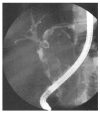Intraductal papillary neoplasm of the bile duct
- PMID: 24379576
- PMCID: PMC3870504
- DOI: 10.3748/wjg.v19.i46.8595
Intraductal papillary neoplasm of the bile duct
Abstract
Intraductal papillary neoplasm of the bile duct (IPNB) is a variant of bile duct carcinoma that is characterized by intraductal growth and better outcomes compared with common cholangiocarcinoma. IPNBs are mainly found in patients from Far Eastern areas, where hepatolithiasis and clonorchiasis are endemic. According to the immunohistochemical profiles of the mucin core proteins, IPNBs are classified into four types: pancreaticobiliary, intestinal, gastric, and oncocytic. Approximately 40%-80% of IPNBs contain a component of invasive carcinoma or tubular or mucinous adenocarcinoma, suggesting that IPNB is a disease with high potential for malignancy. It is difficult to make an accurate preoperative diagnosis because of IPNB's low incidence and the lack of specificity in its clinical manifestation. The most common abnormal preoperative imaging findings of IPNB are intraductal masses and the involvement of bile duct dilation. Simultaneous proximal and distal bile duct dilation can be detected in some cases, which has diagnostic significance. Cholangiography and cholangioscopy are needed to confirm the pathology and demonstrate the extent of the lesions. However, pathologic diagnosis by biopsy cannot reflect the actual stage in many cases because different foci may be of different stages and because mixed pathologic findings may exist in the same lesion. Surgical resection is the major treatment. Systematic cholangioscopy with staged biopsies and frozen sections is recommended during resection to ensure that no minor tumors are left and that curative resection is achieved. Staging, histologic subtype, curative resection and lymph node metastasis are factors affecting long-term survival.
Keywords: Biliary papillomatosis; Intraductal neoplasm; Mucinous; Papillary cholangiocarcinoma; Prognosis.
Figures




Similar articles
-
Intraductal papillary neoplasm of the bile duct: a biliary equivalent to intraductal papillary mucinous neoplasm of the pancreas?Hepatology. 2012 Oct;56(4):1352-60. doi: 10.1002/hep.25786. Epub 2012 Aug 27. Hepatology. 2012. PMID: 22504729
-
Intraductal papillary neoplasms of the bile duct.Int J Hepatol. 2014;2014:459091. doi: 10.1155/2014/459091. Epub 2014 May 18. Int J Hepatol. 2014. PMID: 24949206 Free PMC article. Review.
-
Intraductal papillary neoplasms of the bile duct: stepwise progression to carcinoma involves common molecular pathways.Mod Pathol. 2014 Jan;27(1):73-86. doi: 10.1038/modpathol.2013.112. Epub 2013 Jul 5. Mod Pathol. 2014. PMID: 23828315
-
A Review of Type 1 and Type 2 Intraductal Papillary Neoplasms of the Bile Duct.Curr Med Sci. 2024 Jun;44(3):485-493. doi: 10.1007/s11596-024-2863-5. Epub 2024 May 15. Curr Med Sci. 2024. PMID: 38748369 Review.
-
Clinicopathological characterization of so-called "cholangiocarcinoma with intraductal papillary growth" with respect to "intraductal papillary neoplasm of bile duct (IPNB)".Int J Clin Exp Pathol. 2014 May 15;7(6):3112-22. eCollection 2014. Int J Clin Exp Pathol. 2014. PMID: 25031730 Free PMC article.
Cited by
-
Intraductal papillary neoplasm of the bile duct (IPNB): CT and MRI appearance with radiology-pathology correlation.Clin Imaging. 2020 Oct;66:10-17. doi: 10.1016/j.clinimag.2020.04.036. Epub 2020 May 3. Clin Imaging. 2020. PMID: 32438236 Free PMC article.
-
Unexpected metastasis of intraductal papillary neoplasm of the bile duct without an invasive component to the brain and lungs: A case report.World J Gastroenterol. 2020 Jan 21;26(3):366-374. doi: 10.3748/wjg.v26.i3.366. World J Gastroenterol. 2020. PMID: 31988595 Free PMC article.
-
Extrahepatic Intraductal Papillary Neoplasms of Bile Duct and Klatskin Tumor: Simultaneous Occurrence and Recurrence?ACG Case Rep J. 2024 Sep 27;11(10):e01522. doi: 10.14309/crj.0000000000001522. eCollection 2024 Oct. ACG Case Rep J. 2024. PMID: 40401195 Free PMC article.
-
Intraductal papillary neoplasm of the bile duct: A case report of a rare tumor with a brief review of literature.Int J Surg Case Rep. 2024 Feb;115:109243. doi: 10.1016/j.ijscr.2024.109243. Epub 2024 Jan 15. Int J Surg Case Rep. 2024. PMID: 38237412 Free PMC article.
-
Surgical treatment of mucin-producing cholangiocarcinoma arising from intraductal papillary neoplasm of the intrahepatic bile duct: a report of 2 cases.Korean J Hepatobiliary Pancreat Surg. 2016 Aug;20(3):137-43. doi: 10.14701/kjhbps.2016.20.3.137. Epub 2016 Aug 29. Korean J Hepatobiliary Pancreat Surg. 2016. PMID: 27621752 Free PMC article.
References
-
- Bosman FT, Carneiro F, Hruban RH, Theise ND. WHO classification of tumours of the digestive system. 4th ed. Lyon: IARC; 2010. p. 417.
-
- Rocha FG, Lee H, Katabi N, DeMatteo RP, Fong Y, D’Angelica MI, Allen PJ, Klimstra DS, Jarnagin WR. Intraductal papillary neoplasm of the bile duct: a biliary equivalent to intraductal papillary mucinous neoplasm of the pancreas? Hepatology. 2012;56:1352–1360. - PubMed
-
- Jung G, Park KM, Lee SS, Yu E, Hong SM, Kim J. Long-term clinical outcome of the surgically resected intraductal papillary neoplasm of the bile duct. J Hepatol. 2012;57:787–793. - PubMed
-
- Zen Y, Fujii T, Itatsu K, Nakamura K, Minato H, Kasashima S, Kurumaya H, Katayanagi K, Kawashima A, Masuda S, et al. Biliary papillary tumors share pathological features with intraductal papillary mucinous neoplasm of the pancreas. Hepatology. 2006;44:1333–1343. - PubMed
Publication types
MeSH terms
Substances
LinkOut - more resources
Full Text Sources
Other Literature Sources
Medical

